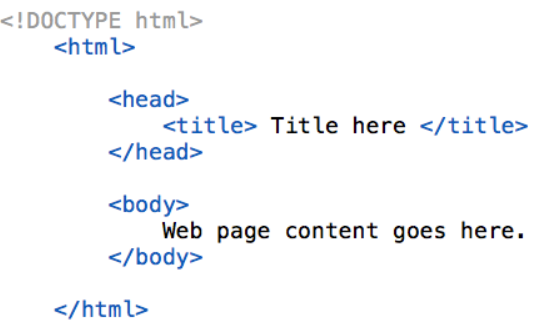
HTML, or Hypertext Markup Language, is the foundation of every web page. It provides the structure and organization necessary for web browsers to display content accurately. Understanding the structure of an HTML document is essential for web developers, as it allows them to create well-formed and accessible web pages. In this article, we will delve into the details of HTML document structure, covering everything from the doctype declaration to essential HTML elements. By the end of this guide, you will have a thorough understanding of HTML document structure, enabling you to create search engine-friendly web pages.
Introduction to HTML Document Structure
HTML documents are structured using a tree-like hierarchy of elements. Each element represents a different part of the document and serves a specific purpose. By following a standardized structure, web developers can ensure compatibility across various browsers and improve search engine visibility.
Doctype Declaration: Defining the Document Type
The doctype declaration is the first line of an HTML document and informs the browser about the version of HTML used. It helps browsers render the document correctly and validates the markup. Here's an example of a doctype declaration for HTML5:
HtmlCopy code
<!DOCTYPE html>
HTML Tag: The Root Element
The HTML tag is the root element of an HTML document and encapsulates the entire content. It is placed immediately after the doctype declaration and before the head element. This element sets the stage for the entire document structure.
Head Element: Document Metadata
The head element contains metadata about the HTML document. It provides information such as the document's title, character encoding, and external resources. Here's an example of a head element:
HtmlCopy code
<head>
<title>Your Page Title</title>
<meta charset="UTF-8">
<link rel="stylesheet" href="styles.css">
</head>
Title Element: Page Title
The title element specifies the title of the web page, which appears in the browser's title bar or tab. It is essential for search engine optimization (SEO) as it helps search engines understand the content of the page. A descriptive and keyword-rich title can improve your page's visibility in search results.
Meta Elements: Additional Metadata
Meta elements provide additional metadata about the web page. They include information such as authorship, description, keywords, and viewport settings. Here are some common meta elements:
- Description Meta Tag : It provides a concise summary of the page's content and is often displayed in search engine results
HtmlCopy code
<meta name="description" content="Your page description">
- Keywords Meta Tag : Although not as influential as in the past, including relevant keywords can still provide some SEO benefits.
HtmlCopy code
<meta name="keywords" content="keyword1, keyword2, keyword3">
- Viewport Meta Tag : It helps in creating a responsive design that adapts to different screen sizes.
HtmlCopy code
<meta name="viewport" content="width=device-width, initial-scale=1.0">
Link Element: External Resources
The link element is used to reference external resources in an HTML document. It is commonly used to link CSS stylesheets, icon files, and JavaScript files. Including external resources helps keep your HTML code clean and separates styling and functionality from the document structure.
HtmlCopy code
<link rel="stylesheet" href="styles.css">
<link rel="icon" href="favicon.ico">
<script src="script.js"></script>
Body Element: Document Body
The body element represents the main content of an HTML document. It contains all the visible elements that users interact with, such as text, images, links, and multimedia. It is within the body element that you structure your web page's content using various HTML elements.

Heading Elements: Organizing Content
Heading elements (h1-h6) are used to define the headings and subheadings of a web page. They provide a hierarchical structure to the content, with h1 being the highest level and h6 being the lowest. Use headings to organize and structure your content, making it more readable and accessible to both users and search engines.
Paragraph Element: Text Content
The paragraph element (p) is used to define blocks of text in an HTML document. It is the most common way to structure textual content. Paragraphs are essential for readability and providing context to the page. Use appropriate paragraphs to break down your content logically and make it easier for readers to digest.
Image Element: Displaying Images
The image element (img) is used to display images on a web page. Images play a crucial role in enhancing the visual appeal and conveying information. When using images, provide descriptive alt text to improve accessibility and include relevant keywords where appropriate.
HtmlCopy code
<img src="image.jpg" alt="Description of the image">
Anchor Element: Creating Hyperlinks
The anchor element (a) is used to create hyperlinks or clickable links on a web page. It allows users to navigate within the same page, to other pages within the same website, or to external websites. When using anchor elements, make sure to provide descriptive link text that accurately reflects the target content.
HtmlCopy code
<a href="<https://www.example.com>">Link Text</a>
Lists: Ordered and Unordered
Lists provide a way to organize items in a specific order or without any order. HTML offers two types of lists: ordered lists (ol) and unordered lists (ul). Ordered lists use numbers or letters to denote the order, while unordered lists use bullet points. Use lists to present information in a structured and easy-to-follow manner.
HtmlCopy code
<ol>
<li>First item</li>
<li>Second item</li>
<li>Third item</li>
</ol>
<ul>
<li>First item</li>
<li>Second item</li>
<li>Third item</li>
</ul>
Table Element: Structured Data
The table element (table) is used to present structured data in rows and columns. It is particularly useful when displaying tabular information, such as financial data, product comparisons, or event schedules. When using tables, ensure that the structure is semantically appropriate and includes appropriate table headers (th) for accessibility.
HtmlCopy code
<table>
<thead>
<tr>
<th>Column 1</th>
<th>Column 2</th>
</tr>
</thead>
<tbody>
<tr>
<td>Row 1, Cell 1</td>
<td>Row 1, Cell 2</td>
</tr>
<tr>
<td>Row 2, Cell 1</td>
<td>Row 2, Cell 2</td>
</tr>
</tbody>
</table>
Forms: User Interaction
HTML forms allow users to input data and interact with a web page. They are used for various purposes, such as contact forms, login forms, and search boxes. When creating forms, use appropriate form elements (input, select, textarea) and provide clear instructions and validation to enhance user experience.
Conclusion
In this comprehensive guide, we have explored the structure of an HTML document, covering key
elements such as the doctype declaration, HTML tag, head element, body element, and various
content elements. Understanding and implementing proper HTML document structure is crucial
for creating well-formed web pages that are search engine-friendly, accessible, and visually
appealing. By following the guidelines outlined in this guide, you will be well-equipped to
create high-quality web pages that can rank effectively in search engine results.
If you enjoyed this piece, we've crafted a related article on How to Create a Custom CSS Contact Form for Your Website. Explore it here.
final thought

by Harsh Verma
final thought

